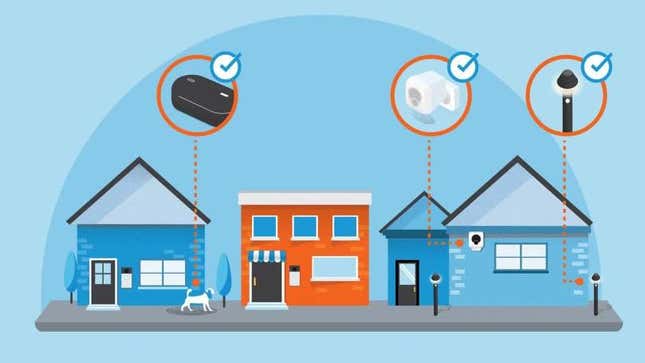
Over the years, Amazon has made it very clear that it’s no longer satisfied with being “the everything store.” What was once just a hub where you buy shit online has since branched into the world of autonomous vehicles, pharmaceuticals, drones, and space travel. Earlier today, the company unveiled some of the details of its newest venture, Amazon Sidewalk, which seems to be an Amazon-branded WiFi network to expand the working range of its connected devices beyond an Amazon customer’s front door.
“With Sidewalk, you can continue to receive motion alerts from your security cameras even when your Wi-Fi goes down,” the announcement reads. “Or if your Wi-Fi does not reach your smart lights at the edge of your driveway, Sidewalk will help them stay connected.”
Amazon first pitched the idea of Sidewalk around this time last year. The company explained that by tapping into the recently-opened 900 MHz band, Bluetooth low energy signals (which hang out around the 2.400 GHz range), and “other frequencies” the Sidewalk team would be able to extend the average home WiFi network to reach smart-devices that would typically be out of range. For instance: controlling smart lights at the end of your driveway, smart sprinklers to water plants lining the porch, or really anything else that might be in your smart yard arsenal.
Today’s announcement expanded on how these devices are going to actually tap into this Sidewalk-sourced WiFi network. Per Amazon, these signals are going to pass through outdoor Ring or Echo devices, which the company calls “Sidewalk Bridges.” (And yes, there are outdoor Ring and Echo devices.) Anyone who happens to have one of these Bridge devices can offer up a tad of their internet bandwidth, which will be lumped together to create Sidewalk’s “shared network” that people can use to keep their Amazon devices connected when they’re out and about.
The exact list of devices primed to connect to this network will be announced “later this year,” according to today’s announcement. Amazon did state that aside from Echo devices, Tile trackers will be on the list, and can tap into this extended wifi to perform their function of helping “find misplaced keys or wallets, or locate a backpack left at a neighborhood picnic.” While I’m not sure how many people might be gathering together to Hang Out in the great outdoors right now, something like this could come in handy once we finally do make that shift—especially if you’re the type that loses things as much as I do.
It’s an interesting concept, but one that largely relies on buying into a specific product ecosystem and trust that the proprietor of that ecosystem won’t screw you over. While the company swears up and down that its network is safe—thanks to three layers of encryption on the network itself and “strong encryption standards” required for all devices plugging into its network—there’s something about the program that doesn’t sit right with me. Maybe it’s because the Sidewalk program largely relies on Ring devices that, in the past, were open to just about anyone who knew how to tap into Amazon’s systems. That carelessness earned Amazon a messy class-action suit at the end of last year, centered around the company’s lax security standards specifically.
That fracas, along with Amazon’s storied history of forking its Ring data over to local police, might make it hard for a lot of folks to opt-into this particular Amazon system. Even if you’re totally on-board with widespread WiFi in concept, maybe we shouldn’t leave it in the hands of something like Sidewalk or Google’s Fiber networks, and push for building out municipal internet instead.